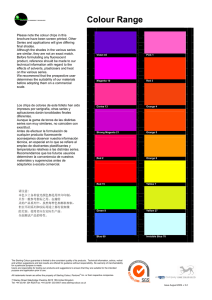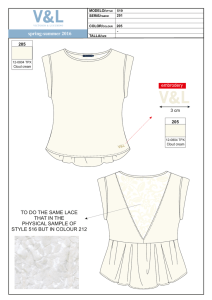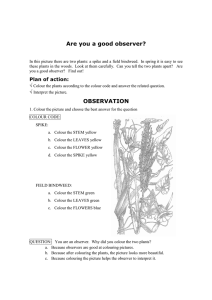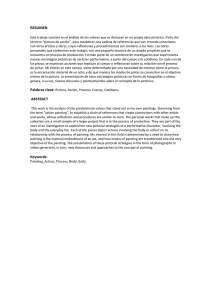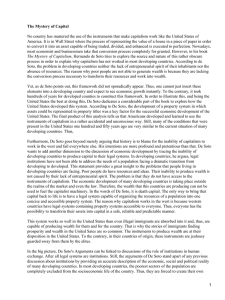Painting according to José Soto
Anuncio
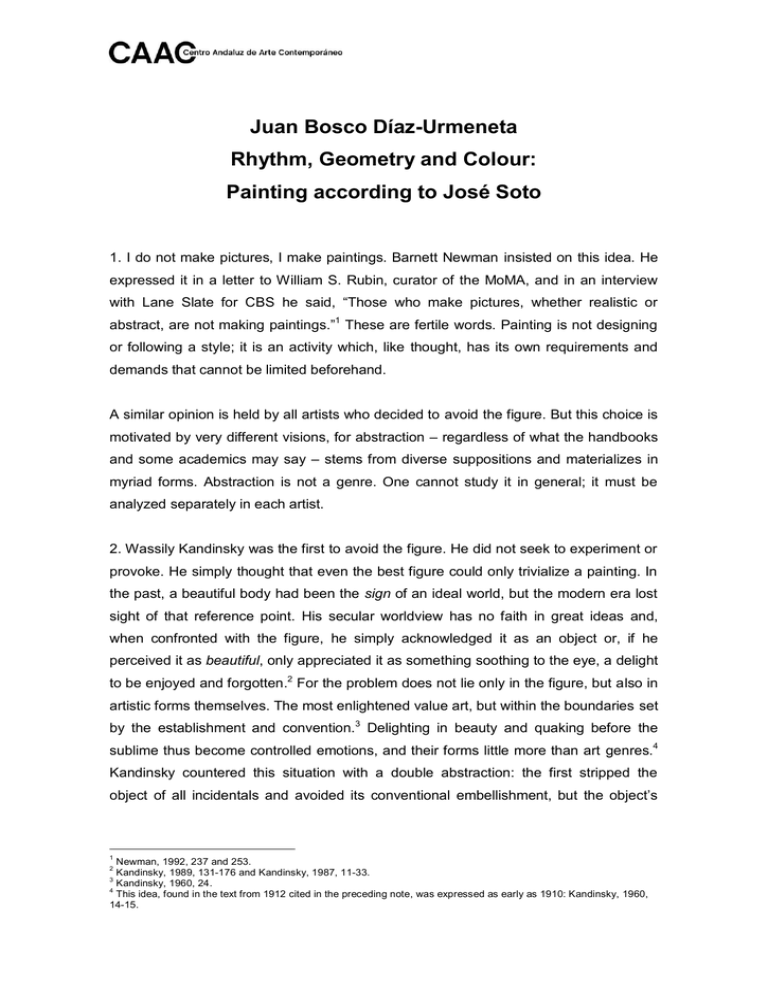
Juan Bosco Díaz-Urmeneta Rhythm, Geometry and Colour: Painting according to José Soto 1. I do not make pictures, I make paintings. Barnett Newman insisted on this idea. He expressed it in a letter to William S. Rubin, curator of the MoMA, and in an interview with Lane Slate for CBS he said, “Those who make pictures, whether realistic or abstract, are not making paintings.”1 These are fertile words. Painting is not designing or following a style; it is an activity which, like thought, has its own requirements and demands that cannot be limited beforehand. A similar opinion is held by all artists who decided to avoid the figure. But this choice is motivated by very different visions, for abstraction – regardless of what the handbooks and some academics may say – stems from diverse suppositions and materializes in myriad forms. Abstraction is not a genre. One cannot study it in general; it must be analyzed separately in each artist. 2. Wassily Kandinsky was the first to avoid the figure. He did not seek to experiment or provoke. He simply thought that even the best figure could only trivialize a painting. In the past, a beautiful body had been the sign of an ideal world, but the modern era lost sight of that reference point. His secular worldview has no faith in great ideas and, when confronted with the figure, he simply acknowledged it as an object or, if he perceived it as beautiful, only appreciated it as something soothing to the eye, a delight to be enjoyed and forgotten.2 For the problem does not lie only in the figure, but also in artistic forms themselves. The most enlightened value art, but within the boundaries set by the establishment and convention.3 Delighting in beauty and quaking before the sublime thus become controlled emotions, and their forms little more than art genres.4 Kandinsky countered this situation with a double abstraction: the first stripped the object of all incidentals and avoided its conventional embellishment, but the object’s 1 Newman, 1992, 237 and 253. Kandinsky, 1989, 131-176 and Kandinsky, 1987, 11-33. Kandinsky, 1960, 24. 4 This idea, found in the text from 1912 cited in the preceding note, was expressed as early as 1910: Kandinsky, 1960, 14-15. 2 3 very nakedness gave rise to the second – transitioning to a constructive poetics that deprived the form of any material reference.5 His proposal rests on two suppositions. The first is the notion of a sentimental bond between men and things, a kind of cosmic empathy.6 This bond, weakened and even destroyed by naturalism in art and materialism in science – two legacies of the 19th century – can be restored (this is the second supposition) by constructing forms if these are the product of a genuine emotion in the artist which, as such, will be passed on to the viewer, heightening his sensibility and his understanding of things.7 Both ideas (in the mystic or late romantic Worringer version) assume that a connection exists between the perception of pure forms (colour, line, plane) and an emotion one might call primal – hence Kandinsky’s continual attempts, which even included the circulation of questionnaires, to analyze and unravel perception. 3. When Kandinsky was exhibiting his first abstract works, Mondrian was beginning his journey to abstraction. Two differences separate them. Kandinsky’s analytical attention to forms contrasts with Mondrian’s concentration on the pictorial rectangle: how to weave and agitate the canvas without giving it depth (hence his works featuring trees) and how to make the picture alter the wall around it. His investigations were more structural than analytical. Moreover, in Mondrian’s view, the principal shortcoming of the art of his time was not the neutralization of emotion by convention but its insensibility to the language of science and the vigour of the human spirit that generated it. The modern was not characterized by materialistic ambitions or a lack of emotion, but by a desire for freedom8 manifested in a philosophy that sought increasingly universal ways of understanding the world. This was what science had done and what art should aspire to do. Rather than naturalism, concerned with the particular appearance of a leaf or a flower, art must seek the universal: tension of form, intensity of colour, harmony.9 This rational weight does not detract emotion from Mondrian’s painting. It stems from an almost epic vision of the desire to know and the freedom that comes from knowing. His position, close to philosophical idealism, contrasts with Kandinsky’s late romanticism, and this difference reveals the divergence between their enquiries into 5 “Painting as Pure Art” (1913) in Kandinsky, 1987, p. 47. Kandinsky, 1987, 28. Kandinsky, 1987, 43. 8 Mondrian, 1983, 15. 9 Mondrian, 1983, 25. 6 7 form: while Kandinsky traces the link between vision and emotion, Mondrian creates a succinct language (a lexicon limited to line, plane, basic colour and greyscale, and a syntax limited to the orthogonal and flat colour) which contrasts richly with the dynamic structure of the picture that emerges from its asymmetry and from the tension between the edges of the canvas and the forms it contains: because they are incomplete, they struggle to escape those confines and carry their rhythm onto the wall. 4. Barnett Newman explored the Mondrian retrospective organized by the MoMA in 1945. His dilemma at the time was what to paint. Realism – whether critical or chronicling urban (T. H. Benton) or rural (Grant Wood) reality – seemed trivial to him. He also proposed an alternative to plastic propriety (Clive Bell’s significant form or good taste) which he called plasmic art, in reference to the artist’s intelligent efforts to conceive forms out of chaos.10 This was the nature of the pre-Columbian, Inuit and Polynesian abstract figures he had studied. They were not ornaments but questions, and not about social tensions but about the risk of living and the terror of death. 11 Mondrian also failed to convince him. Newman appreciated the pure use of form, but he believed that limiting oneself to a restricted formal vocabulary effectively muzzled the exigencies of emotion and philosophical preoccupations.12 While Euclidian Abyss allowed him to settle a score with mainstream art, the following year (1948) his Onement I marked the birth of a painting that reflects on the paradoxes of existence 13 at a time when “our tragedy is again a tragedy of action in the chaos that is society”. 14 He then began turning out a series of paintings consisting of colour fields. Applied uniformly or with subtle variations in hue, the colour of the large planes is broken by thin strips (gestural or with sharply defined edges) that were not lines of separation but narrow bands of colour connecting the larger fields, lending rhythm to the work. At the same time, Newman also criticized beauty. He believed that the sublime was better suited to the tragic temper which he attributed to art,15 an idea that led him to think of painting as something that could inspire a sense of self-awareness and separateness in the viewer16 and, later on, as a place where the individual can know that he is there.17 This shift is exemplified by the transition from Vir Heroicus Sublimis (1950-51) to Stations of the Cross (1958-66), an evocation of Christ’s final cry, lamma 10 “The Plasmic Image” (1945), Newman, 1992, 139-158. “The Ideographic Picture” (1947) Newman, 1992, 107 ff. 12 “The Plasmic Image” (1945) Newman, 1992, 141 ff. 13 Temkin, A., Penn, S., and Ho, M., 2002, 152 and 158. 14 “The New Sense of Fate” (1948), Newman, 1992, 169. 15 “The Sublime Is Now” (1948) Newman, 1992, 170-173. 16 “Interview with David Sylvester” (1965), Newman, 1992, 257-258. 17 “Response to the Reverend Thomas F. Mathews” (1967) and “Interview with Emil de Antonio” (1970), Newman, 1992, 289 and 306. 11 sabachtani! Despite this metaphysical inspiration, Newman’s work became a model for young artists, both minimalist (Judd, Stella) and conceptual (Bochner). 18 Shiff attributes this to his radical abstraction: Newman lets the painting represent itself as the reality it is.19 This is the deepest significance of Newman’s idea quoted at the beginning of this essay: creating a unique, immediate situation in which the painting emerges on its own (this is painting), eschewing all incidentals, narratives and allusions to trends or styles (which would be making a picture). 5. This silence of painting defines the work of José Soto Reyes. His creations do not narrate or describe; they lack props and motifs. It bothered Newman that his works might be viewed as objects. He feared that this would move them closer to the decorative arts. The artists of the next generation shook off that fear: many turned the subtle space that separates object from artwork into the defining territory of their art, frequenting the border zone where the object may or may not evolve into a work of art. This is the challenge that Stella and Donald Judd took on. Soto scouts that border zone without adopting the minimalist aesthetic. He preserves the vigour of the sensory, particularly that of colour. Consequently, the effort is greater. He rejects the coldness of the minimalist project, but this does not mean that he resorts to rhetoric or seduction. In these conditions, in order to make a painting represent itself the artist must engage in a constant give-and-take with the work. He must develop a split personality, be both author and spectator: he must let the work that his hands are bringing to life speak to him. Designs or sketches are limited because painting that way is, above all, a dialogue. The picture is a product of the cooperative efforts of author and material, as if the latter contained virtualities that are only revealed in the very act of painting. Only one criterion governs such a dialogue: the emotion elicited by the painting itself. This is the flimsy hinge that unites the bachelor with the bride. This link between perception and emotion is perhaps the only thing that Soto has in common with Kandinsky, but he does not resort to psychology: the author/spectator must decide for himself, on his own. Otherwise, as Greenberg noted, many of the Russian’s works achieve coherence through veiled allusions to nature,20 something that Soto makes every effort to avoid. 6. The picture is apparently quite simple: a square diagonally divided into two triangles, the upper left one green and the lower right one blue. But there is something off about 18 Zelevansky, 2004, 26 and notes 3 and 97. Shiff, 2004, 78-111. 20 Greenberg, 1961, 111. 19 it. The diagonal isn’t quite a diagonal: it starts in the lower corner, but at the top it veers off to the left of the angle. And below, the green invades the blue, forming a new triangle. Everything is in order, but it moves. The same thing occurs with a thin black band running parallel to the supposed diagonal, which may be a line or a shadow, or even cut into the plane creating a gentle (and ironic) depth. The picture is solid, yet imbued with a subtle vibration. It is this double condition of geometry that makes Soto’s works both construction and motion: the bent lines may indicate tensions between colour fields and perhaps mark emerging spaces that are struggling to create another balance. Soto sees this tension between order and energy in Mondrian, an author he has studied and knows well. The decisive result is rhythm. Mondrian’s geometry loses its alleged coldness once the rhythm becomes apparent. And when that happens, it speaks more to the body than to the eye. It is no coincidence that Mondrian, as many old photos attest, placed rectangles of colour on his studio walls. The expansive quality of his painting contains the seeds of much larger spaces. This is apparent in his Designs for the Salon of Madame B. in Dresden,21 sketches for an interior that never materialized. The subtle rhythm of Soto’s works also requires a larger scale. Without it, the rhythm can only speak to the body through fantasy. His design for an architecture studio, created in the late 1960s, shows this corporeal dimension. The space becomes inhabited. The formats of his recent work conjure up that memory of place, not in the metaphysical sense employed by Newman but, as Richard Serra so simply put it, as spaces for seeing yourself seeing – spaces where the body, when passing through, becomes aware of itself and of its own tempo, tri-part spaces consisting of the work, the venue and every spectator as he experiences the two. 7. In April 1951, Newman exhibited for the second time at the Betty Parsons Gallery. One year earlier, Jackson Pollock had held his most important show at the same venue, for which Tony Smith eliminated any obstacles that might prevent people from viewing works like Autumn Rhythm from a certain distance. For Newman’s show Smith sought the exact opposite effect:22 he installed a small wall in the gallery so that the enormous Vir Heroicus Sublimis, rather than offering itself up for contemplation from any angle, demanded that visitors come closer, stroll along its length, feel the cadence of its rhythms, allow themselves to be engulfed by it. Soto’s recent works offer a similar 21 22 Crego Castaño, 1997, 221. Temkin, 2002, 40 ff. experience, not only because of their rhythm, as I have already mentioned, but also because of the force of their colour. In Soto’s art colour has three characteristics: interactivity, the surprise of nuance and tactile quality. Interactivity, contemplated in another of his favourite authors, Albers, allows him to juxtapose very similar colour fields in order to highlight their differences, thereby achieving variants of light that derive from pigment rather than tonality. In other cases, where two fields are superimposed, the colour varies according to the relative size of the fields. These variations create rhythms which are less obvious than those generated by the lines, but just as effective. A colour can be suitable and even attractive in its industrial version. After all, colour comes from a factory. But the painter can be inventive: he can create a nuance (or tint) so new that it slips between the cracks of the existing colour names, defying classification. These are Soto’s colours, and this is why he is able to give us the surprise of nuance, particularly when his hues are spread across a large field. Dispersed colour is little more than an accessory to form: it serves as a signpost, shapes a space and even helps to rationalize it. But when it floods vast surfaces, it paralyzes and fascinates, especially when it escapes words and eludes names. In those cases, the intellect is left without a concept and the eye is first and foremost that of a sensible body, feeling flesh. But this does not mean that we fall prey to irrationality: the very order of the picture prevents it, but the colour makes us doubt, revealing the limits of an intellect more accustomed to handling things than seeing and accepting them as others. This force of colour intensifies when it is marred by slight alterations: sometimes it merely tinges the canvas, at other times it acquires solidity and density, and occasionally the pigment seems to have been imprinted with slight touches, as if placed there by a stamp. It is then that the colour appeals more to the sense of touch than of sight. It ceases to be a medium in order to configure panoramas and use its inherent beauty as a material.23 More than creating illusions, it simply asserts its presence as colour.24 8. Soto’s works, as I have said, demand that he maintain a constant dialogue with the painting, without any witness other than emotion, a critical emotion that offers no 23 24 Rothko, 2004, 84. Rothko, 2004, 94 ff. excuses and submits to the painting conceived as order and rhythm, material and colour. This rigour shifts his praxis from the visual to the tactile and ultimately to the body. Hence the importance not of size but of scale: with it, the work deploys an enveloping space and helps each onlooker to experience his own tempo. Thus configured, the painting neither narrates nor describes nor expresses; it merely invites each spectator to make it his own, and run the risk of becoming an artist himself. Bibliography Crego Castaño, C., El espejo del orden. El arte y la estética del grupo holandés “De Stijl”. Madrid: Akal, 1997. Greenberg, C., Art and Culture: Critical Essays. Boston: Beacon Press, 1961. Kandinsky, W. De lo espiritual en el arte y la pintura en particular [English title: On the Spiritual in Art], E. Bailey (trans.), Buenos Aires: Nueva Visión, 1960. Kandinsky, W., La gramática de la creación. El futuro de la pintura, Ph. Sers (trans.), Barcelona, 1987. Kandinsky, W., “On the Question of Form”, Kandinsky, W. and Marc, F., in Kandinsky: Complete Writings on Art, Lindsay, K. C. and Vergo, P. (eds.), New York: Da Capo Press, 1994. Mondrian, P., La nueva imagen en la pintura [English title: The New Plastic in Painting], A. Peels (trans.), Valencia: Colegio de Aparejadores de Madrid, 1983. Newman, B., Selected Writings and Interviews, O’Neill, J. P. (ed.), Berkeley/ Los Angeles: University of California Press, 1992. Rothko, M., La realidad del artista [English title: The Artist’s Reality], M. Abdala (trans.). Madrid: Síntesis, 2004. Shiff, R., “Whiteout: The Not-Influence Newman Effect”, Temkin, A. (ed.), Barnett Newman (exh. cat.), Philadelphia, Philadelphia Museum of Art, 2002. Temkin, A., Penn, S., and Ho, M., “Catalogue”, Temkin, A. (ed.), Barnett Newman (exh. cat.), Philadelphia: Philadelphia Museum of Arts, 2002. Zelevansky, L. “Beyond Geometry: Objects, Systems, Concepts”, Zelevansky, L. (ed.), Beyond Geometry: Experiments in Form, 1940s-1970s. Cambridge, Mass./London: MIT Press, 2004. Juan Bosco Díaz-Urmeneta Seville, spring 2012
